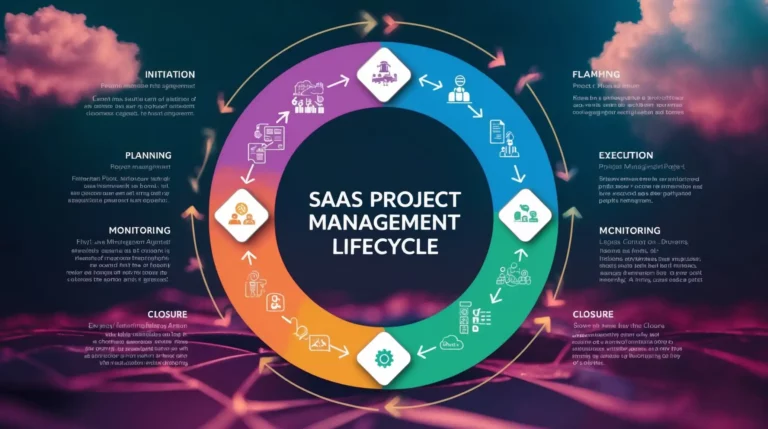AI-Powered SaaS for Business Automation: The Ultimate Guide

AI-powered SaaS for business automation is changing the way companies operate. These subscription-based software applications can automate and improve various processes by using artificial intelligence technologies, such as machine learning (ML) and natural language processing (NLP).
With AI integrated into their systems, businesses can:
- Boost productivity
- Enhance customer experiences
- Streamline operations
This article will explore how AI transforms traditional SaaS solutions and makes organizations more efficient. We’ll discuss:
- The inner workings of AI-powered SaaS
- The benefits it offers
- Its applications across industries
- The challenges it faces
- The future trends shaping the industry
Our audience supports Ahcrypto. When you click on the links on our site, we may earn an affiliate commission at no extra cost to you. Learn More.
Understanding AI-Powered SaaS

Artificial Intelligence (AI)-powered Software as a Service (SaaS) integrates advanced technologies like machine learning (ML) algorithms and natural language processing (NLP) to revolutionize business processes.
Key Components:
- AI: Enables systems to simulate human intelligence.
- ML: Algorithms that allow software to learn from data without explicit programming.
- NLP: Facilitates interaction between computers and humans through natural language.
How These Technologies Work Together
AI, ML, and NLP combine to enhance SaaS applications‘ automation, personalization, and decision-making capabilities.
- AI drives intelligent decision-making by analyzing large datasets.
- ML algorithms learn from these data patterns to improve the accuracy of predictions.
- NLP allows for more intuitive user interactions by understanding and responding to human language.
Scope and Applications
AI-powered SaaS finds applications across various industries:
- Healthcare: Automating patient records management with predictive analytics for better diagnosis.
- Finance: Enhancing fraud detection and automating customer service through chatbots.
- Retail: Personalizing shopping experiences with dynamic pricing models based on consumer behavior.
These technologies collectively offer transformative potential for businesses looking to optimize operations and drive innovation.
The Role of AI in Enhancing SaaS Applications
Artificial Intelligence significantly impacts decision-making within SaaS applications by providing actionable insights through predictive analytics. These insights help businesses anticipate customer needs, optimize operations, and enhance efficiency.
Predictive Analytics in CRM Systems
1. Salesforce Einstein
Leverages predictive analytics to forecast sales trends, identify potential leads, and recommend the best actions for closing deals. This allows sales teams to prioritize efforts on high-value prospects.
2. HubSpot CRM
Utilizes AI to analyze customer interactions and predict future behavior. This enables personalized marketing campaigns that drive higher engagement rates.
Using AI-driven predictive analytics in Customer Relationship Management (CRM) systems transforms raw data into valuable insights. This foresight empowers organizations to make informed decisions, ultimately driving sales growth and improving customer satisfaction.
Moreover, integrating AI-powered CRM with predictive analytics further enhances these systems’ capabilities, allowing for even more precise forecasting and customer behavior analysis.
AI-enhanced SaaS applications integrate seamlessly into existing workflows, ensuring businesses remain competitive by leveraging data-driven strategies.
Key Benefits of Integrating AI into Business Automation Strategies
Leveraging AI-powered SaaS tools offers several significant advantages to organizations. These benefits are driving the rapid adoption of such technologies across various industries.
1. Streamlining Repetitive Tasks Through Automation
AI tools automate routine tasks, freeing up valuable time for employees to focus on strategic activities. Tasks such as data entry, scheduling, and invoicing can be efficiently handled by AI, reducing human error and increasing productivity.
2. Quick Analysis of Large Data Sets for Enhanced Decision-Making
AI-powered SaaS solutions can swiftly analyze vast volumes of data, providing actionable insights that inform better business decisions. For instance, machine learning algorithms can identify patterns and trends in customer behavior, enabling companies to adapt their strategies effectively.
3. Tailored Experiences for Customers Based on Their Behavior Patterns
Personalization is a key strength of AI-powered SaaS tools. These tools can create customized experiences that enhance customer satisfaction and loyalty by analyzing customer interactions and preferences. Examples include personalized marketing campaigns and product recommendations based on past purchases.
4. Achieving Cost Efficiency While Maximizing Return on Investment (ROI)
Automating processes not only saves time but also reduces operational costs. Organizations can achieve higher cost efficiency by minimizing the need for manual intervention. Additionally, the insights gained from AI-driven analytics help optimize resource allocation, maximizing ROI.
By integrating AI into business automation strategies, organizations can unlock new levels of efficiency and innovation. This transformation not only streamlines operations but also creates a more responsive and personalized customer experience, ultimately driving growth and competitiveness in the market.
Popular Applications of AI-Powered SaaS Tools in Business Automation
Several AI-powered SaaS tools are making significant strides in business automation, driving efficiency and productivity within organizations.
1. Salesforce Einstein AI
Salesforce Einstein AI is a robust tool that brings predictive analytics to sales processes. By leveraging this AI tool, businesses can:
- Forecast sales trends and customer behavior.
- Automate data entry and lead scoring.
- Provide personalized recommendations for the next steps in the sales cycle.
2. HubSpot
HubSpot integrates AI to enhance marketing, sales, and customer service efforts. Key areas where HubSpot excels include:
- Tailoring email marketing campaigns based on user interactions.
- Utilizing chatbots to provide instant customer support.
- Analyzing data from various touchpoints to optimize marketing strategies.
3. Slackbot
Slackbot, part of the Slack platform, streamlines workflows by automating routine tasks. Its functionalities include:
- Setting reminders and scheduling meetings.
- Answering common questions using pre-programmed responses.
- Integrating with other tools to facilitate seamless communication across teams.
4. DocuSign
DocuSign leverages AI to simplify document management and electronic signatures. Benefits of using DocuSign include:
- Streamlining contract approvals and signing processes.
- Reducing errors through automated form filling.
- Tracking document status in real-time for better project management.
These tools exemplify how AI-powered SaaS applications can transform business operations and enhance efficiency and decision-making capabilities across various departments.
Market Growth and Statistics: The Rise of AI Adoption in the SaaS Industry

The SaaS industry has experienced remarkable growth, driven by the integration of AI technologies. According to statistics on AI adoption in the SaaS industry, market revenue surged from $31.5 billion in 2015 to an impressive $171.9 billion by 2022.
Key factors contributing to this growth include:
- Increased Efficiency: AI tools streamline operations, reducing time spent on repetitive tasks.
- Enhanced Decision-Making: Access to predictive analytics enables better strategic decisions.
- Cost Savings: Automation lowers operational costs while maximizing ROI.
AI-enabled SaaS solutions are becoming indispensable across various sectors, reinforcing their role in driving business transformation and efficiency.
Challenges Faced When Integrating AI into Existing SaaS Solutions
When integrating AI-powered SaaS for business automation, organizations encounter several challenges:
1. Data Privacy Concerns
Cybersecurity risks in SaaS applications are a significant issue. AI systems often require vast amounts of data to function effectively, raising concerns about data breaches and unauthorized access. Ensuring robust encryption and stringent access controls is essential to protect sensitive information.
2. Biases Present in Algorithms
AI algorithms can inadvertently perpetuate biases present in training datasets. These biases can lead to unfair or discriminatory outcomes, particularly in hiring or loan approvals. To mitigate these issues, organizations must audit and refine their algorithms regularly.
3. Transparency Issues
Ethical considerations surrounding the use of artificial intelligence include the need for transparency in AI decision-making processes. Users and stakeholders must understand how AI systems make decisions. Providing clear explanations and maintaining an open dialogue about AI operations helps build trust and accountability.
Addressing these challenges requires a combination of technological solutions and ethical practices. By focusing on data security, algorithmic fairness, and transparency, businesses can harness the full potential of AI powered SaaS while mitigating associated risks.
Future Trends Shaping the Landscape of AI-Powered Business Automation Tools
Emerging trends are set to redefine AI powered business automation tools.
1. Ethical Practices in AI Development
One significant trend is the emphasis on ethical practices in developing artificial intelligence systems. Companies are increasingly focusing on ethical design principles to enhance user experiences. This includes ensuring transparency in AI algorithms, which helps build trust with end-users by clarifying how decisions are made.
2. Improved User Customization
Another trend is improved user customization through more intuitive and adaptive interfaces. AI capabilities are evolving to understand and anticipate user needs, offering a more personalized experience. For instance, AI-driven chatbots are becoming more sophisticated, providing seamless customer support that feels genuinely human.
3. Integration with IoT
Integration with IoT (Internet of Things) is another area gaining traction. By combining AI with IoT devices, businesses can achieve real-time data processing and decision-making, leading to smarter operations and proactive problem-solving.
4. Commitment to Responsible AI Use
The rise of AI ethics boards within organizations signals a commitment to responsible AI use. These boards oversee the development and implementation of AI technologies, ensuring they align with ethical standards and societal values.
Additionally, there’s a growing focus on sustainable practices within AI, which involves reducing energy consumption and minimizing the carbon footprint of AI operations.
Emerging trends indicate a future where AI powered SaaS tools are more powerful and aligned with ethical considerations, offering enhanced and trustworthy user experiences.
Using Data Analytics and Artificial Intelligence Together for Strategic Insights

Understanding user behavior through data analysis techniques is essential in today’s competitive market. Businesses can gain strategic insights that drive innovation and growth by combining data analytics with AI.
Techniques for Analyzing User Data
1. Market Trend Analysis
- Utilize AI algorithms to detect emerging trends within large datasets.
- Predict future market movements by examining historical data patterns.
2. Customer Segmentation
- Apply machine learning models to group customers based on behaviors and preferences.
- Tailor marketing strategies to specific segments for improved engagement.
3. Sentiment Analysis
- Natural language processing (NLP) is used to gauge customer sentiment from reviews and social media.
- Adjust product offerings based on the feedback trends identified.
4. Predictive Modeling
- Implement predictive analytics to forecast customer needs and behaviors.
- Enhance inventory management by predicting product demand cycles.
5. Churn Prediction
- Identify at-risk customers using machine learning models focused on churn indicators.
- Develop retention strategies to reduce customer turnover rates.
Strategic Benefits
- Competitive Advantage: Gain deeper insights into market dynamics and stay ahead of competitors.
- Enhanced Decision-Making: Make informed decisions based on comprehensive data analysis.
- Increased Personalization: Deliver tailored experiences that meet individual customer needs effectively.
Combining AI with robust data analytics techniques allows businesses to understand their customers better and refine their strategies for sustained growth.
Actionable Strategies to Effectively Apply Insights Derived from Analytics Tools Within Organizations

Implementing data-driven decision-making processes successfully requires strategic planning and execution. Here’s a step-by-step guide to help you leverage AI-powered SaaS for business automation:
1. Define Clear Objectives
- Identify specific goals you want to achieve with data analytics, such as improving customer satisfaction or optimizing supply chain processes.
- Ensure these objectives align with your overall business strategy.
2. Invest in the Right Tools
- Choose AI-powered SaaS tools that offer robust analytics capabilities tailored to your needs.
- Evaluate options based on features like predictive analytics, real-time data processing, and user-friendly interfaces.
3. Data Collection and Integration
- Aggregate data from various sources, including CRM systems, social media, and internal databases.
- Use integration tools to ensure seamless data flow across platforms.
4. Data Cleaning and Preprocessing
- Ensure the quality of your data by removing duplicates, filling in missing values, and correcting errors.
- Implement preprocessing steps like normalization and transformation to prepare data for analysis.
5. Advanced Analytics Techniques
- Apply machine learning algorithms to uncover patterns and trends within your data.
- Use natural language processing (NLP) for sentiment analysis and text mining.
6. Visualization and Reporting
- Utilize dashboards and visualization tools to present insights in an understandable format.
- Generate regular reports that highlight key metrics and actionable insights.
7. Decision-Making Framework
- Develop a framework that incorporates analytics insights into your decision-making process.
- Encourage a culture of data-driven decision-making across all levels of the organization.
8. Continuous Monitoring and Optimization
- Regularly monitor the performance of your analytics initiatives.
- Make necessary adjustments based on feedback and evolving business needs.
9. Training and Development
- Invest in training programs to enhance employees’ analytical skills.
- Foster an environment where team members are encouraged to experiment with new tools and techniques.
Integrating these strategies ensures you maximize the potential of AI powered SaaS in driving innovation forward within your organization.
Conclusion: Embracing the Future with Confidence
The future of business automation powered by artificial intelligence software-as-a-service solutions looks promising. AI-powered SaaS for business automation offers unmatched opportunities to streamline operations, improve decision-making, and provide personalized customer experiences.
Businesses that embrace these technologies can gain a competitive advantage. By integrating AI into their SaaS platforms, organizations can:
- Optimize Processes: Automate repetitive tasks and free up valuable human resources.
- Drive Innovation: Use data insights to fuel strategic initiatives.
- Improve Customer Satisfaction: Offer tailored experiences based on predictive analytics.
The potential of AI powered SaaS solutions is huge. As the industry changes, businesses with these advanced tools will be well-equipped to succeed in an increasingly digital world.
Embrace the change, harness the power of AI, and unlock new levels of efficiency and growth for your organization.
FAQs (Frequently Asked Questions)

Scott Evans
Hey there, I’m Scott Evans, your friendly guide at AhCrypto! I’m all about breaking down complex SaaS, AI, and tech topics into digestible insights. With me, you’re not just keeping up with the tech world; you’re staying ahead of the curve. Ready to dive into this exciting journey? Let’s get started!






